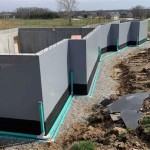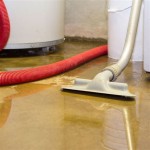How to Install Drain Tile in Basement
Water damage and basement flooding could become a significant problem for homeowners. Fortunately, installing drain tile is an effective solution that helps keep basements dry and free from water damage.
Drain tile, also known as French drain, is a perforated pipe designed to collect and drain excess water around your foundation. Installing this system effectively channels groundwater away from your basement, preventing flooding and moisture-related issues.
Materials You'll Need:
- Corrugated drain tile
- Perforated drain sock (optional)
- Gravel or crushed stone (3/4-inch diameter or less)
- Landscaping fabric or filter fabric
- Measuring tape
- Level or laser level
- Shovel
- Trenching tool (manual or powered)
- Hand tamper
- Downspout adapter (if connecting to downspouts)
- Cleanout pipes or access points (optional)
Step-by-Step Instructions:
- Plan the Layout: Determine the areas of your basement most prone to water seepage. Mark the perimeter of the basement where you plan to install the drain tile system.
- Dig the Trench: Excavate a trench along the marked perimeter, approximately 6-12 inches wide and 12-24 inches deep. Ensure the trench is deep enough to accommodate the drain tile and a layer of gravel beneath.
- Level the Trench Bottom: Use a level or laser level to ensure the bottom of the trench is level. This will allow water to flow freely through the drain tile.
- Install Gravel Base: Spread a layer of gravel or crushed stone approximately 2-4 inches deep along the bottom of the trench. This layer provides filtration and support for the drain tile.
- Lay the Drain Tile: Place the perforated drain tile along the center of the gravel base. Ensure the perforations are facing down to allow water to enter the pipe.
- Cover the Drain Tile (Optional): Wrap the drain tile with a perforated drain sock. This layer acts as an additional filter, preventing dirt and debris from clogging the tile.
- Backfill with Gravel: Fill the trench around the drain tile with more gravel or crushed stone. This layer filters water and prevents soil from entering the pipe.
- Install Landscaping Fabric: Cover the gravel layer with landscaping fabric to prevent soil migration and maintain the integrity of the drain system.
- Connect to Downspouts (Optional): If desired, install downspout adapters to connect the drain tile to your downspouts. This diverts rainwater away from the foundation.
- Install Cleanout Pipes (Optional): Place cleanout pipes or access points along the drain tile system. These allow for inspection and cleaning if necessary.
- Test the System: Pour water along the drain tile system to ensure it is functioning properly. Water should flow freely into the drain tile and away from the basement.
Tips:
- Use high-quality perforated drain tile with a sturdy construction.
- Ensure the drain tile is laid on a level grade to facilitate proper water flow.
- Compact the gravel backfill to prevent settling and maintain the integrity of the system.
- Regularly inspect and clean the drain tile system to maintain its effectiveness.
Installing drain tile in your basement is a rewarding project that can protect your home from water damage and flooding. By following these steps, you can effectively control groundwater and keep your basement dry and comfortable.

Basement Drain Tile Installation In Your Home Beltsville Md Aquaguard Waterproofing

Drain Tile System Installation Drainage Culvert Pipe French Catch Basin Covers

What Is Drain Tile Epp Foundation Repair

Basement Repair Waterproofing Concrete Leveling In Michigan

Top 5 Star Basement Interior Drain Tile System Solutions

Remedial Drainage Options Waterproof Magazine

Drain Tile Can Save Your Basement American Dry

French Drain Installation In Kansas City Foundation King

Drain Tile Systems Offer Ultimate Water Protection For Your Home

Drain Tile Can Save Your Basement American Dry








